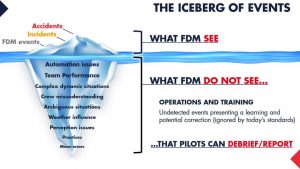An independent company with 22 years of expertise in flight data animation for Flight Safety and Pilot Training
Flight data and human perception: A huge potential still to be better exploited!
#Perception #FlightData #FlightAnimation #FOQA #FDM #FlightSafety #PilotTraining #APilotsView #ForASaferSky
Flight data & flight safety today: which usage?
Today’s general approach is to use the data collected from the DFDR (Digital Flight Data Recorder) during the flights. This data passes through computer filters analyzing exceedances based on defined triggers’ values. Incidents or violations are then reported to the crews involved and used for statistical purposes, analyzing fleet performances.
Another source of information for Flight Safety departments consists of the compulsory and/or voluntary reports filed by the crews.
Nowadays, flight data is still too often something perceived with extreme caution by pilots, especially when their airlines are using flight data to put pressure on them and use this data as a punitive tool to demonstrate exceedances or mistakes.
For sure, willful negligence or gross violation of company SOP (Standard Operating Procedures) have to be kept under control and punished if necessary. On the other hand, if pilots can have access by themselves to flight data in an easy way, in order to understand their own performances, massive new opportunities will show up.
Two concepts are keys to flight safety: just culture & reporting culture
Today, in many fields but particularly in aviation, two main concepts are emerging:
- the «just culture»,
- and a directly related concept, a healthy «reporting culture».
Having these both elements in use, a major new safety improvement is emerging:
HAVING THE HUMAN PERCEPTION IN THE SYSTEM AS A SAFETY PROTECTION

It is s well known, especially in a dynamic complex environment, that many things may occur at the same time. In today’s highly automatized cockpits, the complexity of the systems and all the small snags occurring in daily operations are usually realized and corrected by the pilots. That’s why, as long as no trigger is reached by the recorded flight data, most of such events are ignored, except if pilots make a spontaneous report.
Correcting such minor occurrences is everyday life for a pilot. A large majority of them are ignored by the safety team on today’s standards. They represent the underwater part of the iceberg:

Snags and “near incidents” … the almost unexploited – until now – potential to improve flight safety!
If all pilots would report every single snag and small occurrence, flight safety would be overwhelmed by reports.
On the other hand, the issues having been realized and solved are for now a non-occurrence (nothing is recorded) and will not pop up as a potential danger to flight safety officers, as long as it is not correctly reported.
Who is in a better position to judge the potential danger lying within an event realized and corrected? Well, most probably the pilots who have been exposed and who solved the problem.
But why don’t pilots report such snags?
The reasons can be multiple: the fear of consequences, complacency (“someone else will anyway report about it someday”), the time pressure because of the immediate next flight …
Even in my company, which has a very healthy approach towards the “just culture”, I have to admit that sometimes I did not think about reporting occurrences that could have been interesting.
The reason is mainly that human beings have limited recording capacities. In a complex situation, doubts can exist about having perceived correctly a whole event. Pilots also may be unsure of having screwed up something and thus feel uncomfortable to report.
Not sure? No reports… which leads to less safety!
An operator bulletin published a few months ago surprised me. It quoted in a potential flaw of the flight guidance system. I remember that the explained problem happened to me once, years ago, during a speedy approach: The flight guidance system changed during intercept from LOC-G/S (Localizer Glide Slope) to HDG-G/S (Heading Glide Slope). According to the FCOM (Flight Crew Operating Manual), the G/S is exclusively working with LOC engaged. As we were in a very dynamic process, we only had time to rapidly correct this event in order to remain stabilized and move on to other tasks related to the landing preparation during the high workload process of the final approach.
After landing, we quickly debriefed the occurrence, first trying to understand if we did something wrong, trying to understand why this unusual mode change happened. We had no answer and started to be uncertain of what we had seen: Were all the modes really like we believed having seen them? As a consequence, being unsure, no report was filled.
After the publication of this bulletin, discussing the raised issue, many colleagues told me that they also had experienced this strange flight guidance mode; but not a single one of them had reported it!
I am glad that no accident related to this issue occurred in the meantime, I would have had a terrible feeling of having not reported something that could have saved a plane and its passengers.
There must be a way to change this!
The way is to raise the confidence of pilots to write a report!
Visualizing and replaying flights on the basis of the recorded data from the flight data recorder: most probably the best solution to have more confidence in reporting!
CEFA Aviation has developed a new self-analyzing tool called CEFA AMS. Besides its training and self-learning aspect discussed in previous posts (LINK CEFA BLOG), the visual representation of the real cockpit instruments and annunciators can be a very helpful tool to improve the quality, details, and precision of a report.
All FMGS (Flight Management and Guidance System) modes can be displayed, this way the dynamic of the situation, the length of an occurrence, and its magnitude can be realized and fully understood.
Having an exact representation of recorded DFDR data on the instruments, all accurate values can be realized and analyzed in detail – not only the subjective perception.
By using CEFA AMS, the quality of the reports can be massively improved, having the facts also immediately available and being able to confront the perceptions of both pilots of the flight deck.
This new service will also raise the confidence of reporting, eliminating the doubt of being the one who screwed up something. Having the opportunity to show with animation the dynamic of an event gives the possibility to point out – almost without words – potential dangers that would have been minimized in a written static report.
Imagine also the possibility of sharing experiences in words and in a visual way with the flight safety team minutes after the flight by an animation: This would be much more informative and convenient than a lengthy report.
Another benefit of flight data animation: improving the communication and understanding between pilots and technicians
Imagine being able to show the technician’s strange occurrences that happened, directly after the flight. Nowadays, how many times do I hear from a technician that what I am reporting is not possible for XY reasons… closing finally the aircraft logbook with a “check on the ground, found OK”. Definitely frustrating!
Another issue is to have the technician asking for details about what happened on a remote instrument; but our eyes being focused on the prime issue during the flight, it is often impossible to give him/her a valid answer, as I did not realize what was the value on the remote indication required for his/her analysis.
With a CEFA AMS animation, everything is visible, exact recorded values can be extracted and the dynamic and length of an event can be understood. An incredible improvement!
Imagine a crew being able to share with the flight safety department a situation perceived as challenging, but that didn’t trigger any event. Thereafter, if the airline allows it, such an anonymized version of this animation for other pilots can be published to become a source of self-briefing and safety improvement.
Some threats cannot be realized only by hard-recorded facts.
The sensitivity of the human perception is also a great sensor that might pro-actively perceive potential danger, based on feeling and experience.
LET THE HUMAN BEING WITH ALL HIS KNOWLEDGE, FEELING AND SENSITIVITY ACT AS A BETTER SAFETY PROTECTION!
Do you agree or disagree? Share your personal thoughts in the comments below!
You can also come & discuss with me personally on CEFA Aviation stand, booth #210 during the World Aviation Training Summit (WATS) in Orlando, USA, from 30th April to 2nd May 2019.
Next to be read: “Flight safety and line pilots’ training tools: A new winning team!”
Find all my other articles gathered here.
You can also contact me via LinkedIn or via this link. Talk to you soon!


Safety-II: the brand new concept of the “complex” Swiss Cheese Model 2/2
Flight safety and pilots’ line training tools: a new winning team!